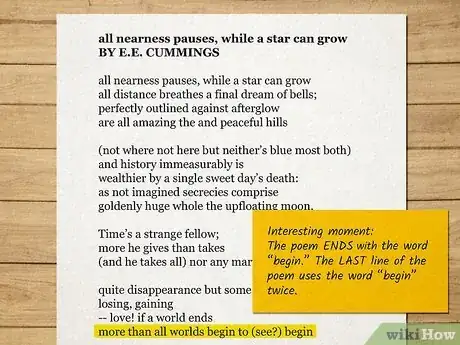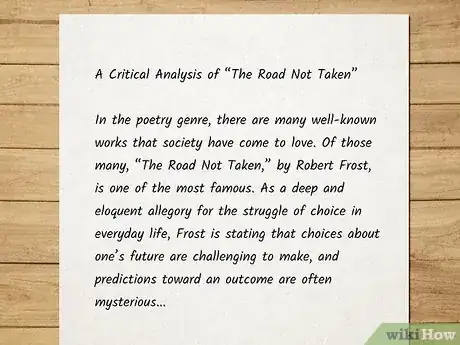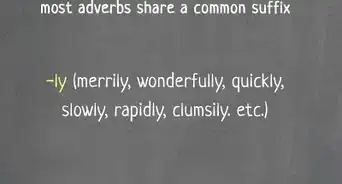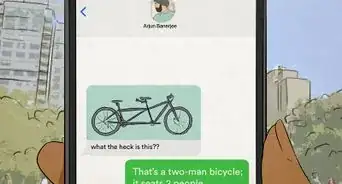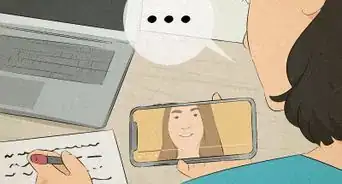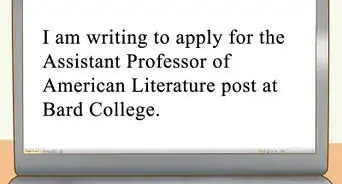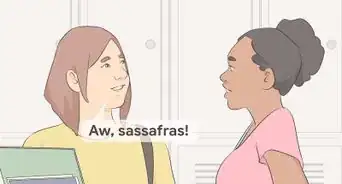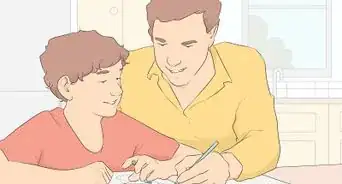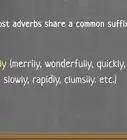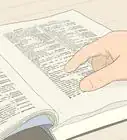wikiHow is a “wiki,” similar to Wikipedia, which means that many of our articles are co-written by multiple authors. To create this article, 19 people, some anonymous, worked to edit and improve it over time.
This article has been viewed 131,488 times.
Learn more...
Deconstruction aims to disturb in order to discover. By deconstructing a text, you learn to read beyond a text's straightforward content and uncover new meanings and truths. Deconstruction has intellectual and political implications. Deconstructing a text is a common assignment given to students of literature, literary theory, film, communications, or postmodernist thought.
Whenever deconstruction finds a nutshell—a secure axiom or a pithy maxim—the very idea is to crack it open and disturb this tranquility - John D Caputo.
Steps
-
1Look for the assumptions. An article entitled 'how to deconstruct a text' likely assumes a text can be deconstructed, and also that that deconstruction can be described in a systematic way that applies to all texts similarly. Neither of these assumptions may be true. Look for what assumptions the writer makes that already bias the interpretation of the meanings the text discusses.[1]
-
2Look for the tension between the spirit and the letter of the text. A text is rarely entirely successful in conveying the spirit of the writer, while the letter of the text is invariably ambiguous as to the intended meaning. The spirit behind the title 'how to deconstruct a text' is one of helpfulness: yet despite this optimism, deconstruction can be a difficult concept to grasp, while 'how tos' are also notorious for being inadequate, incomplete, misleading - a one-size fits all solution that rarely fits even a single context adequately. There is potentially a direct contradiction and tension here between what the author intends and what the text ends up saying. Such disconnects can lead to misinterpretations, to a literal translation of the meaning, which one assumes is automatically a false interpretation. Such separation between the spirit of the text and the actual text itself are inevitable in any text, but revealing them empowers the reader and avoids the pitfall of a text literally falling into decay, into an almost eternal misinterpretation. Likewise, a text is itself an attempt to 'author' reality, and there is a tension that inevitably comes with that.Advertisement
-
3Consider the dynamic and static elements of meaning:- One way to approach the meanings of text is to realise that we construct meanings in our heads dynamically - they are subject to constant revision, extension, refutation, qualification or summary in our heads. A physical text on the other hand has a static character, even while the writer attempts to recreate the dynamic elements of a thought process. As a project to construct meaning, a sentence or paragraph must eventually end, while a thought process can potentially continue endlessly in developing or modifying meanings. A text constructs a reality, an author and even a reader that are inevitably fraudulent, because they are in many ways dead in comparison to that which they point to. In sum, people are alive, texts are dead, but a text gives the illusion of life, but something is inevitably lost in the process - deconstruction attempts to fill in this gap by making it clear how the text comes to life through the reader's interpretation and through the manipulations of the author.
-
4Consider how the text is made irrelevant. Imagine an alien landed on Earth. The mere fact of being an alien would bring great scrutiny and learning, even though the alien would look and talk exactly like us. By seeing how a text is made irrelevant, we turn the text into an alien object, and thereby bring to bear an intensified level of scrutiny. Disturb in order to discover. Rather than take the context of the text for granted, we seek to find the limits of meaning built into the text, the point at which it becomes alien to us, and in so doing, we discover something new about it.
-
5Consider the individual elements of the text. This is often the first step in deconstruction, but it can be misleading, as it suggests meaning is the sum of separate parts and not something more than the sum of the parts. Consider how the text uses different kinds of words, nouns, verbs, adverbs etc. A text that describes the world using verbs constructs a different kind of world (existential) than one that focuses on nouns (essentialist/positivist), or adjectives (relativist). Likewise, a text that uses verbs like 'appear', 'seem', or 'ponder' give a different sense of reality than one using verbs like 'is', 'creates', 'proves' etc. In the deconstruction project, every single word is a hypothesis about the world, not a statement of fact, and reflects as much about the author and even the reader than about the 'world out there'. Deconstruction aims to make these hypotheses visible.[2]
-
6Look for puns and words with double meaning. Read your text slowly and methodically. Do not assume that a first-glance reading will supply you with a text's meaning. Instead, resolve to dig deeply into every word or phrase. Circle any word that might have multiple meanings or that leads to a pun or joke. Reread any sentence with a double meaning and try to keep both meanings in your head simultaneously. Use your dictionary to guide you as you uncover the multiple meanings within a text. Ask yourself:
- Does this word have any other definitions besides the standard, assumed definition? For example, the word "start" can mean "to begin." It can also mean "to become startled." The sentence "He started when he heard the gun" might mean that the man began an action at the gunshot (such as beginning a race). However, it might also mean that the man became startled and scared at the gunshot. Try to keep both meanings of "start" in your head while you read.
- Is this word etymologically related to other words in the text? For example, the words "inspiration" and "conspiracy" are both related to the Latin root word "spirae," meaning breath. Does this history help you find additional meaning in these words?
- Does the word sound like another word or phrase that is entirely unrelated to it? For example, the word "Russian" is not etymologically related to "rush in" in any way. However, because these words sound a lot alike, a reader might connect them in surprising ways, leading to additional significance in a text.
- Is this word used in a different way elsewhere in the text, and how might they be related? For example, perhaps the word "art" is used in one chapter to refer to a painting and "Art" is used in another chapter to refer to a person. How are "art" and "Art" alike? How are they different?
-
7Hunt for overlooked explanations or definitions. Deconstruction urges a reader to resist the general, common meaning of a text, also known as the "privileged" meaning of a text. Consider whether a word, phrase, or text might have alternative explanations that are ignored by many readers. Are there alternative or minority perspectives that have not been given their due? Try to expose unconventional ideas and possibilities as you read. Ask yourself:
- What is unconventional or strange about the text? Are there any traditions that the text is flouting? These traditions might be literary (such as using an unconventional structure) or political (such as inhabiting a feminist perspective).
- How would this text be different if it had been narrated from another character's perspective? This is an especially good question to ask if the narrator is a white heterosexual man and there are minor characters who embody minority identities. What if this text had taken up the perspective of a woman, a person of color, or someone who is queer?
- What ideology is being supported by the text? Does the text seem to suppress any other ideologies? For example, perhaps the text anxiously supports Western imperialism. Is there anything the text leaves out in order to strengthen its imperialist position?
- What is the text's relationship to seemingly universal truths? Deconstruction resists the idea that there is one single Truth to explain life and language. Does the text resist these false truths as well? For example, one generally accepted truth is that "people should follow their consciences." Perhaps a text is arguing that people's consciences are flawed and that morality should be sought elsewhere.
- What hierarchies exist in the text? Who has the power? Is there any way that the text overturns hierarchies? Could you overturn hierarchies through your reading?[3]
- What words could the author have chosen but did not choose? Are there any gaps or fissures in the text that you can discern?
-
8Push back against the authority of the author. Resist the temptation to look to the author of a text as the singular expert on the meaning of a given text. Tell yourself that your own readings, ideas, translations, and even your misreadings are just as meaningful as the author's interpretation of her own work. The act of reading is creative, not passive: you should not defer to any single authoritative explanation for a text's meaning.[4]
-
9Embrace ambiguity, playfulness, and contradictions. Deconstruction resists the idea that language follows a straightforward formula as it creates meaning.[5] Instead, language is strange, funny, disturbing, and paradoxical. Tell yourself that deconstruction does not involve finding the "one true meaning" of a work of literature. You might find that a text means two opposite things at the same time. This does not mean that the text is wrong or that you have misread the text: look at the text as presenting a multiplicity of truths. Expect to find jokes, playful puns, disturbing ideas, and paradoxes when you deconstruct a text.
-
10Examine the text in another order. Texts are usually read from beginning to end. However, that kind of linear thinking might obscure other hidden meanings within the text, such as surprising connections, double-meanings, and puns. Consider disrupting a linear reading of a text by skimming through it backwards, jumping around from chapter to chapter, and reading certain phrases and sentences in isolation. Reading a text in a nonlinear fashion can bring it to life in new and unexpected ways.[6]
-
11Resist Western cultural binaries. Deconstruction argues that language contains political claims that disguise their own politics: in other words, that seemingly "straightforward" language is a mask for pernicious and arbitrary power structures. One of the clearest ways these power dynamics play out in language is through a system of Western cultural binaries (or opposites) that create problematic hierarchies.[7] Deconstruction can help make visible certain problematic invisible assumptions in language and culture. In order to deconstruct a text, learn how to get beyond a simplistic system of binaries that culture creates and that language might try to uphold. Try to see where there are shades of grey, where seeming opposites are actually very closely related, or where the "superior" side of the binary system might in fact be inferior. These binaries include the following:
- Men vs. Women (or masculine vs. feminine)
- Culture vs. Nature
- Soul/Mind vs. Body
- Reason vs. Emotion
- White people vs. People of color
- Adult vs. Child
- "Good" literature (like Shakespeare) vs. "Bad" literature (like a romance novel)
-
12Apply deconstruction to any text. If you are deconstructing a text for a school assignment, you will probably apply this method to a literary text such as a poem, play, short story, or novel. However, deconstruction can be applied to any text or any speech act. Movies, advertisements, political speeches, how-to articles, and billboards can all be deconstructed too. Look at the world around you as one made of deeply meaningful text that you have the power to decode if you take the time.
-
13Distill your observations into a claim. If you are deconstructing a text as part of an assignment, you might have to write up your findings. This can be a difficult task because academic papers have to be clear, organized, and decisive, whereas a deconstructed text is confusing, ambiguous, paradoxical, and disordered. Nevertheless, you can still create a cohesive argument out of a deconstructed text. To do so, consider using the following sentence structures to begin to organize your thinking:
- "Even though the text appears to argue X, my reading shows that the text also argues Y."
- "The text allows a reader to understand that the binaristic relationship between A and B is problematic in the following ways . . ."
- "The text creates a surprising connection between P and Q through the use of puns and hidden jokes. This is meaningful because . . ."
Warnings
- The only danger is thinking you know what deconstruction is. By attempting to go beyond the appearance or structure of text, deconstruction is more like a pointer to a possible destination than a complete description of the destination. We simply don't know what we will discover before we carry out a deconstruction. In that sense, we move from a place of darkness to a place of light. Yet conversely, in terms of the meaning of a text, we move from a place of light to a place of darkness. This is best summed as saying 'we come to know something of that which we don't know'.⧼thumbs_response⧽
- While I hope some of these points and comments in this 'how too..' are useful, they only give you one lens on deconstruction. Aim to discover yet more lenses.⧼thumbs_response⧽
References
- ↑ https://penandthepad.com/deconstruct-text-2122472.html
- ↑ https://www.education.vic.gov.au/school/teachers/teachingresources/discipline/english/literacy/Pages/jointly-deconstructing-texts.aspx
- ↑ http://www.iep.utm.edu/deconst/#SH2b
- ↑ https://penandthepad.com/deconstruct-text-2122472.html
- ↑ http://public.wsu.edu/~delahoyd/decon.html
- ↑ https://literariness.org/2016/03/22/deconstruction/
- ↑ https://literariness.org/2016/03/22/deconstruction/
- ↑ http://www.oed.com/
About This Article
If you need to deconstruct a text, start by reading through the work carefully to find any assumptions the writer may have made. For instance, if the author of the text assumes that readers who are females all want to be mothers, you can then deconstruct the rest of their argument by showing how that false assumption affects the rest of the piece. To do this, look for words like “appear” or “seem” in place of stronger words such as “is” or “proves,” since these may show a weakness in the original argument. For tips on how reading a text from beginning to end can help you deconstruct it, read on!





